In recent years there has been a lot of talks about Matera in terms of tourism.
Not only because it was the European Capital of Culture in 2019, but also because it is a unique city in Italy, rich in history and magic.
Actually, Matera had already started to be known all over the world at the beginning of the nineties, when the Sassi district became a UNESCO World Heritage Site.
From that moment on the city experienced a continuous growing in interest and curiosity from tourists, both Italians and Internationals.
In this article, based on our personal experience, we are going to provide you with some practical information and useful tips to organize a perfect visit in Matera.
Table of Contents
- History of Matera
- Visit Matera, tips and facts
- Where to Stay in Matera
- What is the best way to get around Matera
- Sassi Matera City Card
- How much time to spend in Matera
- How to get to Matera
- Where to park
- What to eat in Matera
- Matera in the Movies
History of Matera
Matera is considered the third oldest city in the world, after Jericho and Aleppo and dates back to 2000 BC.
The discovery of some historical finds, however, lead to think that already in prehistoric times some caves of the Murgia Materana were inhabited.
The current urban conformation took shape from the seventh century and had a remarkable development in the Middle Ages, especially in the Civita district.
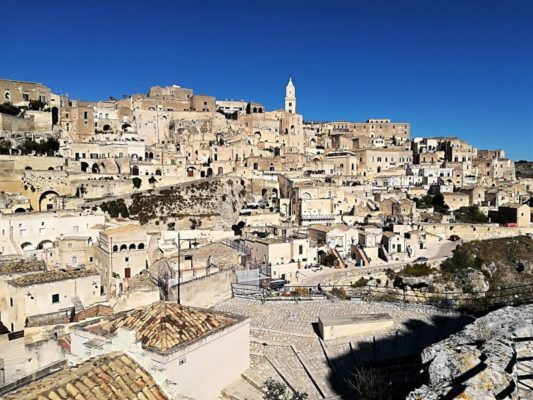
Sassi of Matera
The two most important districts of the historic city center, however, are certainly the Sassi and their story deserves to be told.
The Sasso Barisano is so called because it faces towards Bari, while the Sasso Caveoso looks south, towards Montescaglioso.
They are an interweaving of stratified houses dug into limestone, cisterns and underground tunnels for water supply.
In the first decades of the twentieth century these houses were inhabited by poor families.
Living conditions were precarious both due to overcrowding and insufficient sanitary standards.
Following the italian De Gasperi law of 1952, the eviction of the Sassi began, which lasted until 1968.
It involved about 17,000 people who were relocated to the new purpose-built residential neighborhoods in the city.
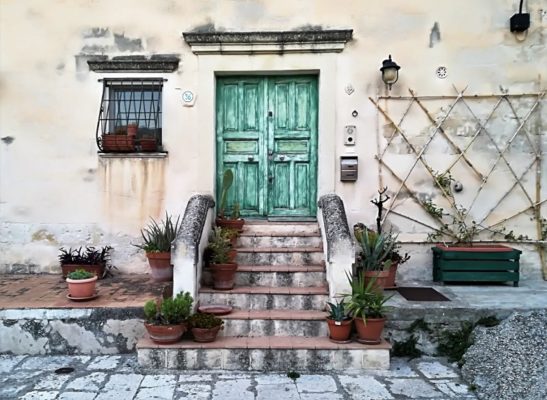
Sasso Caveoso
Since 1993 the Sassi of Matera came back to life with a new look, while remaining at the same time still anchored to its history.
Work began on the environmental redevelopment and renovation of the houses, which were equipped with water, gas and electricity.
A sewer system was also planned and built.
From that moment on, most of the houses of the Sassi were converted into Bed & Breakfasts, boutique hotels, bars, restaurants, art galleries and craft shops.
Finally, some caves have been used as a House Museum.
Visit Matera, tips and facts
Our visit to Matera represented the last stage of a larger tour, which had started with an eight-day itinerary in Salento and then continued with a visit to the Valle d’Itria.
My parents had been here many years ago with an organized trip and they had always described it with great enthusiasm, increasing in me the curiosity to visit it.
All that was missing was the right opportunity to do it, which finally arrived in October 2020.
Where to stay in Matera
One of the experiences that we recommend you to live in Matera is to stay in the Sassi area. The facilities are numerous and you will be spoiled for choice.
We stayed at B&B Gradelle Pennino, located in Sasso Caveoso.
We can tell you that it turned out to be an ideal location to visit the city, as most of the places of interest in Matera are just a few minutes away by foot.
The best part of the building is definitely the terrace, where breakfast is served in fine weather.
From up there, in fact, you can enjoy a spectacular view of the Sassi roofs, so much so that we had specially carved out moments of relaxation to enjoy the city from this privileged position.
Other benchmarks, like cleanliness, comfort and breakfast are good.
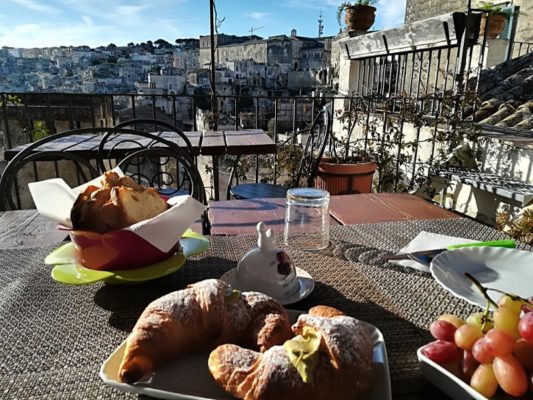
Bed & Breakfast Gradelle Pennino
Some of our acquaintances stayed instead at 5 Elementi Sassi and from what they told me they had a very good time there.
It is located in the northern area of Sasso Barisano, the B&B seems to be housed in a cave but the furniture is modern and attractive.
Moreover, one of the added values of this Bed and Breakfast is the suggestive view that can be admired from the terrace.
What is the best way to get around Matera
Thanks to its urban layout, the historic center of Matera can be easily explored on foot.
Indeed, in our opinion, this is the most suitable way to visit it, since it is an area full of charm in a tangle of narrow sloping alleys.
It is also possible to visit the historic city center with an expert English speaking guide.
He or She will help you discover all the most important attractions of this stunning city through an organized Walking Tour.
As concerns pure transport services, the Bus Miccolis company offers rides from the parking lot in via Saragat to Piazza San Pietro Caveoso in the Sassi district, with numerous stops along the way.
The Sassi Line runs every half hour from 7.30 to 20.00 and the ticket costs € 1,50.
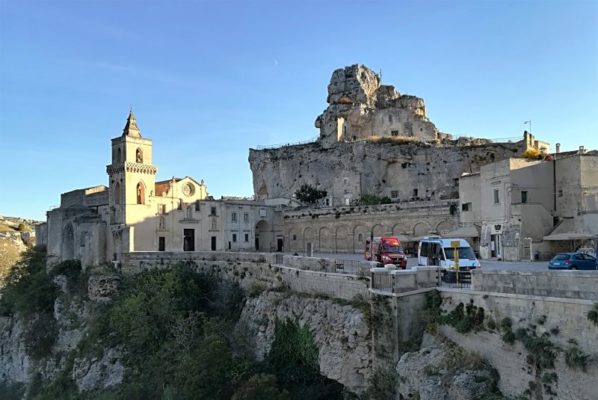
Piazza San Pietro Caveoso (Bus stop)
Sassi Matera City Card
In case you plan to stay for two days, the Sassi di Matera City Card will give you the opportunity to visit three attractions plus a museum of your choice, between the Museo Immersivo della Bruna and the Museo Racconti in Pietra.
The attractions included in the tourist card are the Church of Madonna delle Grazie, Casa Grotta and the rupestrian church of Sant’Antonio Abate.
The Museo Immersivo della Bruna is located in the heart of the Sasso Barisano.
Thanks to a multimedia tour, the socio-religious aspects of the famous patronal feast dedicated to the Brown Virgin are illustrated.
The Museum of Paleontology and Geology “Racconti in Pietra” is particularly suitable for children.
Inside it is possible to take a journey through the history, the environment and the territory of the Murge and Matera.
The card is valid for 48 hours from the time of first use (not purchase).
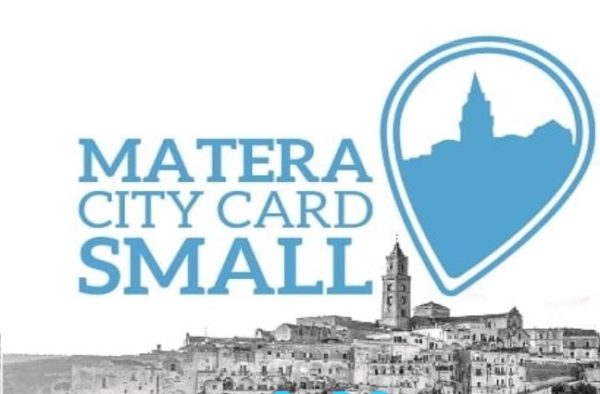
La Sassi di Matera City Card
How much time to spend in Matera
Matera should be lived with a slow pace.
Drifting through the narrow stepped alleys of the historic city center, admiring the sunset from one of the many belvederes, tasting the typical products of Matera’s cuisine.
Spending the night here means fully experiencing the charming atmosphere of the evening, when several tourists have already left the city.
For this reason, unlike those who are forced to a hit-and-run, we had decided to dedicate a full day and a half to the visit of Matera.
In our opinion it is the bare minimum to start exploring the history and culture of the city with the correct times.
How to get to Matera
The most practical way to get to Matera is certainly to have your own vehicle (or rental).
The nearest airport is the Karol Wojtyła of Bari, which is about 60 kilometers away.
From the capital of Puglia there are numerous daily train and bus rides, operated by the Ferrovie Appulo Lucane company. The journey time is about 1 hour and 40 minutes.
There are also other private companies that cover the route, as well as connecting Matera with Potenza, Naples, Salerno and the most important cities of Puglia.
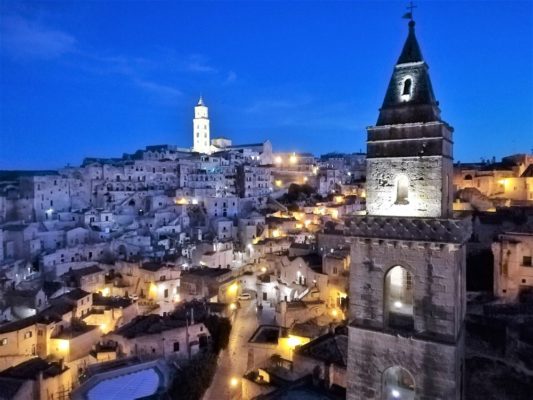
Matera by night
Where to park
Since in the historic center of Matera there is a ZTL (Limited Traffic Zone), we needed to leave the car parked for about two days.
We were also looking for something that was not too far from the structure that hosted us for the night.
We found a good compromise in via Lanera. Along the street there’s the university campus, some school buildings and the Tramontano Castle.
We had parked a few hundred meters from Via Lucana, parallel to the central Via del Corso and the stop was free.
In the center, however, there are also paid parking lots and garage silos.
What to eat in Matera
Those who already follow us on the blog already know that to learn about the social dynamics of a city we usually take a tour of its market.
For us it represents a kind of identity card of the place in which we are.
We had chosen the one located in Piazza Ascanio Persio, right in the city center, full of stalls of fruit, vegetables and typical products.
Taking advantage of the opportunity, we had made a nice supply of legumes to take home, including grass pea and black chickpeas.
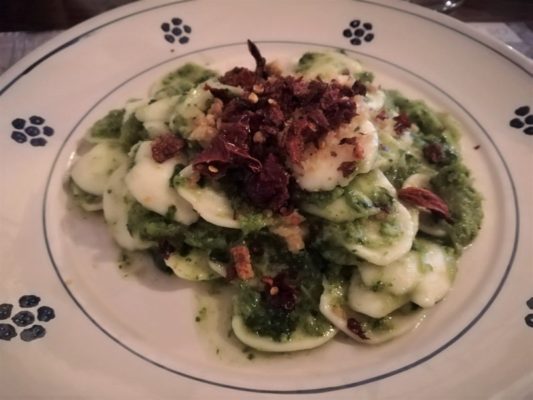
Strascinate con cime di rapa
The Matera IGP bread is definitely one of the products to try in the city.
It has the shape of a croissant and it is long-lasting. It is made with sourdough and durum wheat semolina.
In the past, a stamp was affixed to the crust for recognition purposes. In fact, families had only two “shared” ovens in the city for cooking, after preparing the dough at home.
For dinner we had chosen taverns that offered an experience of taste among the typical dishes of the cuisine of Matera.
From Orecchiette with turnip greens and cruschi peppers to the Crapiata, passing through the Cialledda.
The last two are poor dishes of the Lucanian rural tradition, which have their strength in the choice of the ingredients used for the preparation.
Crapiata is a soup of legumes and cereals and is usually prepared for thanksgiving.
The hot Cialledda instead is made with stale bread, potatoes, onion and wild herbs.
All washed down with a good glass of Matera DOC Primitivo and Aglianico del Vulture DOC.
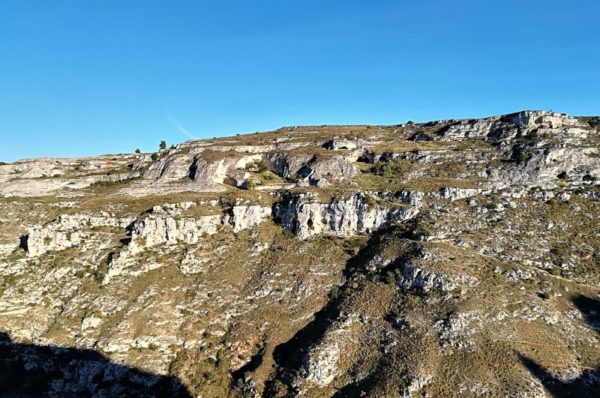
Parco della Murgia
Matera in the movies
To make a trip to Matera complete, we recommend you visit some places that have become famous on the big and small screen.
Thanks to their particular architectural and environmental conformation, the Sassi of Matera have been used numerous times as a movie set since the Second World War.
In fact, there are about eighty films that have been set in Matera and its surroundings, as well as various documentaries and television dramas.
Among all the works, the only time that the Sassi represented themselves was in Carlo Lizzani’s 1949 documentary, inspired by Carlo Levi’s famous novel Cristo si è fermato ad Eboli.
Three times, instead, the Sassi became on the screen the city of Jerusalem.
In Pier Paolo Pasolini’s Gospel according to Matthew (1964), in King David (with Richard Gere) in 1985 and finally in Mel Gibson’s Passion of christ in 2003.
Finally, Matera was the set of other important movies.
We mention only some of the most famous: La Lupa by Alberto Lattuada in 1953, Cristo si fermato a Eboli by Francesco Rosi in 1979, Wonder Woman by Patty Jenkins in 2017, Veloce come il Vento by Matteo Rovere in 2016.
Now you get all basic info to organize a wonderful visit to Matera. Have you a nice stay.
0 Comments